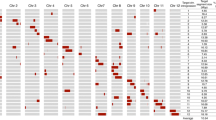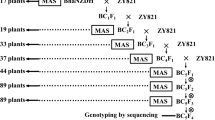Summary
A molecular marker analysis of a near-isogenic line (NIL), its donor parent (DP), and its recurrent parent (RP) can provide information about linkages between molecular markers and a conventional marker introgressed into the NIL. If the DP and RP possess different alleles for a given molecular marker, and if the NIL possesses the same allele as the DP, then it is reasonable to presume a linkage between that molecular marker and the introgressed marker. In this study, we examined the utility of RFLPs as molecular markers for the NIL genemapping approach. The allelic status of fifteen RFLP loci was determined in 116 soybean RP/NIL/DP line sets; 66 of the ‘Clark’ RP type and 50 of the ‘Harosoy’ RP type. Of the 1740 possible allelic comparisons (116 NILs x 15 RFLP loci), 1638 were tested and 462 (33.9%) of those were informative (i.e., the RP and DP had different RFLP alleles). In 15 (3.2%) of these 462 cases the NIL possessed the DP-derived RFLP allele, leading to a presumption of linkage between the RFLP locus and the introgressed conventional marker locus. Two presumptive linkages, pK-3 — and pK-472 — Lf i, were subsequently confirmed by cosegregation linkage analysis. Although not yet confirmed, two other associations, pk-7 ab and pK-229 — y 9 seemed to be plausible linkages, primarily because the pk-7 — ab association was detected in two independently derived NILs and both markers of the pK-229 — y 9 association were known to be linked to Pb. The data obtained in this investigation indicated that RFLP loci were useful molecular markers for the NIL gene-mapping technique.
Similar content being viewed by others
References
Allard RW (1956) Formulas and tables to facilitate the calculation of recombinational values in heredity. Hilgardia 24: 235–278
Apuya NR, Frazier BL, Keim P, Roth EJ, Lark KG (1988) Restriction fragment length polymorphisms as genetic markers in soybean, Glycine max (L.) Merrill. Theor Appl Genet 75: 889–901
Bernard RL (1976) United States national germplasm collections. In: Hill LD (ed) World soybean research. Interstate Printers and Publ. Danville, IL, pp 286–289
Chandlee JM, Vodkin LO (1988) An unstable mutation affecting soybean seed coat color. Soybean Genet Newsl 15: 177–179
Dretzen G, Bellard M, Sassone-Corsi P, Cambon P (1981) A reliable method for the recovery of DNA fragments from agarose and arylamide gels. Anal Biochem 112: 295–298
Fehr WR (1987) Principles of cultivar development. Vol 1 — Theory and technique. Macmillan Publ, New York
Feinberg AP, Vogelstein B (1983) A technique for radiolabelling DNA restriction endonuclease fragments to high specific activity. Anal Biochem 132: 6–13
Holmes DS, Quigly M (1981) A rapid boiling method for the preparation of bacterial plasmids. Anal Biochem 114: 193–197
Keim P, Shoemaker RC (1988) Construction of a random recombinant DNA library that is primarily single copy sequence. Soybean Genet Newsl 14: 147–148
Keim P, Diers BW, Palmer RG, Shoemaker RG (1989a) Mapping the soybean genome with RFLP markers. In: Pascale AJ (ed) Proc World Soybean Research Conference IV, 5–9 March 1989, Buenos Aires, Argentina, pp 1246–1251
Keim P, Shoemarker RC, Palmer RG (1989b) Restriction fragment length polymorphism diversity in soybean. Theor Appl Genet 77: 786–792
Kiang YT (1987) Mapping three protein loci on a soybean chromosome. Crop Sci 27: 44–46
Muehlbauer GJ, Specht JE, Thomas-Compton MA, Staswick PE, Bernard RL (1988) Near-isogenic lines — a potential resource in the integration of conventional and molecular marker linkage maps. Crop Sci 28: 279–735
Muehlbauer GJ, Specht JE, Stawick PE; Graef GL, ThomasCompton MA (1989) Application of the near-isogenic line gene mapping technique to isozyme markers. Crop Sci 29: 1548–1553
Palmer RG, Kilen TC (1987) Qualitative genetics and cytogenetics. In: Wilcox JR (ed) Soybeans: improvement, production and uses, 2nd edn. Agronomy 16: 135–209
Saghai-Maroof MA, Soliman KM, Jorgensen RA, Allard RW (1984) Ribosomal DNA spacer-length polymorphisms in barley: Mendelian inheritance, chromosomal location, and population dynamics. Proc Natl Acad Sci USA 81: 8014–8019
Southern EM (1975) Detection of specific sequences among DNA fragments separated by gel electrophoresis. J Mol Biol 98: 503–517
Staswick PE (1988) Soybean vegetative storage proteins structure and gene expression. Plant Physiol 87: 250–254
Suiter KA, Wendell JF, Case JS (1983) Linkage-1. J Hered 74: 203–204
Thorson PR; Hedges BR, Palmer RG (1989) Genetic linkage in soybean: linkage group 14. Crop Sci 698–700
Weis MG (1970) Genetic linkage in soybeans. Linkage groups II and III. Crop Sci 10: 300–303
Young ND, Zamir D, Ganal MW, Tanksley SD (1988) Use of isogenic lines and simultaneous probing to identify DNA markers tightly linked to the Tm-2a gene in tomato. Genetics 120: 579–585
Author information
Authors and Affiliations
Additional information
Communicated by A. L. Kahler
Published as Paper no. 9101, Journal Series, Nebraska Agric. Res. Div. Project no. 12-091. Research partially funded by a grant from the Nebraska Soybean Development, Utilization, and Marketing Board
Rights and permissions
About this article
Cite this article
Muehlbauer, G.J., Staswick, P.E., Specht, J.E. et al. RFLP mapping using near-isogenic lines in the soybean [Glycine max (L.) Merr.]. Theoret. Appl. Genetics 81, 189–198 (1991). https://doi.org/10.1007/BF00215722
Received:
Accepted:
Issue Date:
DOI: https://doi.org/10.1007/BF00215722




